Layout and features
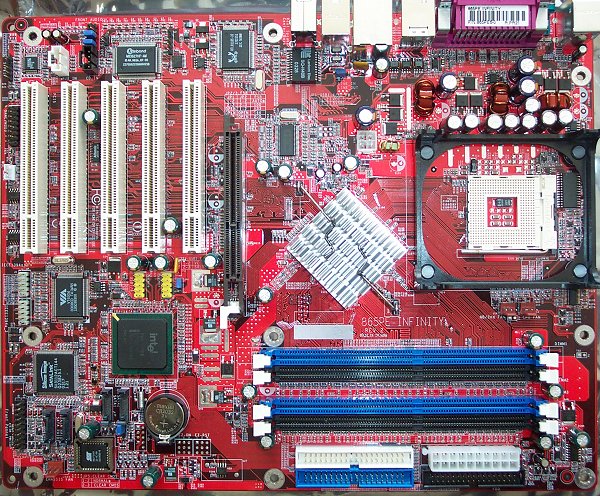
We'd all be forgiven for thinking this is an MSI board. That red colour has become synonymous with the Taiwanese giant. As silly as this may initially sound, DFI needs to adopt a colour scheme and stick by it. Brand familiarity is a good thing, and DFI will do well if they keep to a certain style. First impressions are good. A number of integrated components and a large North Bridge heatsink don't seem to unduly crowd the board.
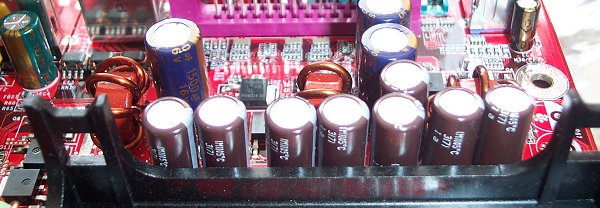
Whereas ABIT sought fit to outfit its MAX3 with some kind of active cooling, DFI is content to keep the status quo. The CPU socket is lined with a number of high-quality Capacitors from the likes of TEAPO. DFI implements a three-phase power regulation system that should keep stock systems ticking away ever so nicely. As this is a Springdale board, the CPU socket's lever points towards the North Bridge. This, we feel, makes cooler installation that little bit easier than on most Canterwoods. The socket area is large enough to accommodate aftermarket coolers that use the four mounting holes. The same can be said for water-cooling.
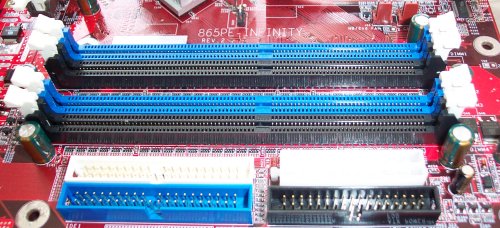
Some more goodness comes in the form of 2 fan headers (out of a possible 3 on the board). Enthusiasts will generally look to enhance the stock cooling options, so not having to connect up to a MOLEX is handy. We also like the fact that most of a PC's cabling is kept out of the way. the exception being the 12v power connector. 2 sets of DDR slots afford dual-channel running with utter simplicity. Fill slots of a certain colour or fill the 4 slots for high RAM usage. The IDE and floppy ports' fittings, we reckon, should be the other way around. If the notches were reversed, the cables would fit in a little easier. Whether to cool the North Bridge actively or passively is a question that has split a number of manufacturers down the middle. Some, like MSI, insist on putting some LED-laden fan cooling. Others prefer a larger passive heatsink. DFI chooses the passive option, much to our ears' delight. Small fans can often be unnecessarily noisy. It would have been nice if the N.B's heatsink had been a little further away from the socket for installation's sake. Also locating the DIMM slots a little more to the right would have allowed RAM removal without having to remove the AGP card from its 8x slot. The close proximity of the first PCI slot means that you can't really use it if a decent AGP card is used. The card cooler's airflow is almost bound to restricted by the PCI card's PCB.
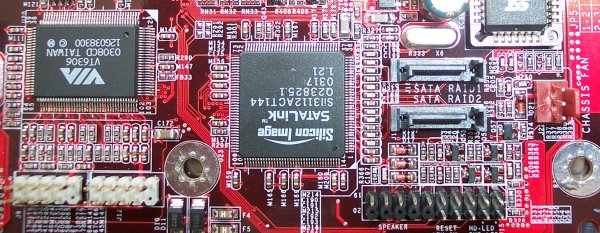
SATA connectivity is all the rage now, that's what motherboard manufacturers are trying to tell us. The DFI i865PE INFINITY comes laden with Intel ICH5 goodness, which means that it only supports SATA in independent formats. By virtue of having SATA support on-chip, the DFI doesn't needlessly punish the PCI bus. That job is left to the now ubiquitous Silicon Image Sil3112A 2-port controller. It may not have the desirable on-chip characteristics present in the ICH5/R, but it does offer RAID0 and RAID1 support, and it's a cinch to setup. Poor, ole IDE RAID has been firmly shown the door, it seems. One omission present in the ICH5/R was FireWire support. VIA's VT6306 3-port single-chip controller does the honours. Two headers are found below (no bracket included, though) and the remaining port sits on the back panel. The ICH5 also offers copious lashing of USB2.0, and a possible 4 ports can be connected to the yellow headers close by. One small point here, it would be nice if everyone adopted ABIT-style board jumpers. The small clear CMOS jumper was a pain to get to at times.
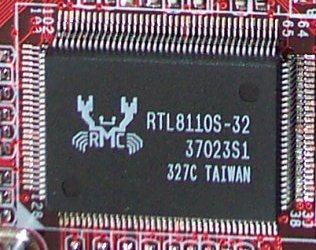
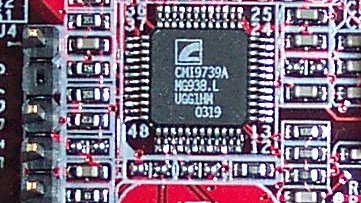
The PCI bus, not content with some bashing from FireWire and SATA ports, is further punished with the inclusion of a PCI-based Realtek 8110S Gigabit Ethernet controller, presumably chosen on its cost attractiveness when compared to the Intel CSA solution. That's a lot of bandwidth riding through the PCI bus, but we'd be surprised if it was all used concurrently. CMI's excellent 9739 6-channel CODEC is used to provide reasonable on-board AC'97 sound. RCA S/PDIF connections are found on the back panel, too.

RCA S/PDIF connections are usually reserved for add-on cards, so their inclusion is nice to see. 6-channel sound jacks and Gigabit LAN ability make it a decent I/O section. 4x USB2.0 and 1 FireWire socket gives decent connectivity. Decent component layout on the whole makes this one of the better Springdale boards in recent times.









